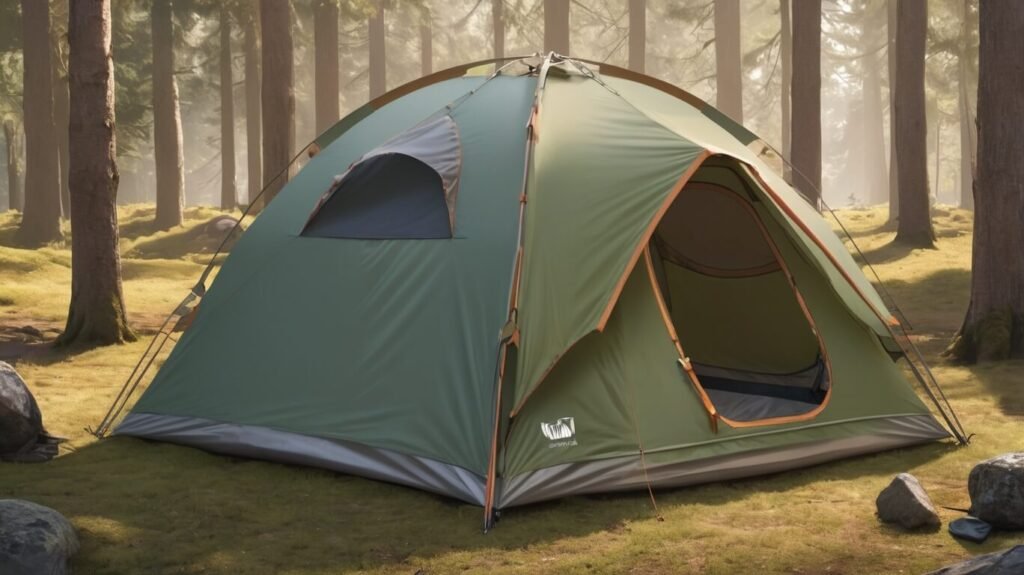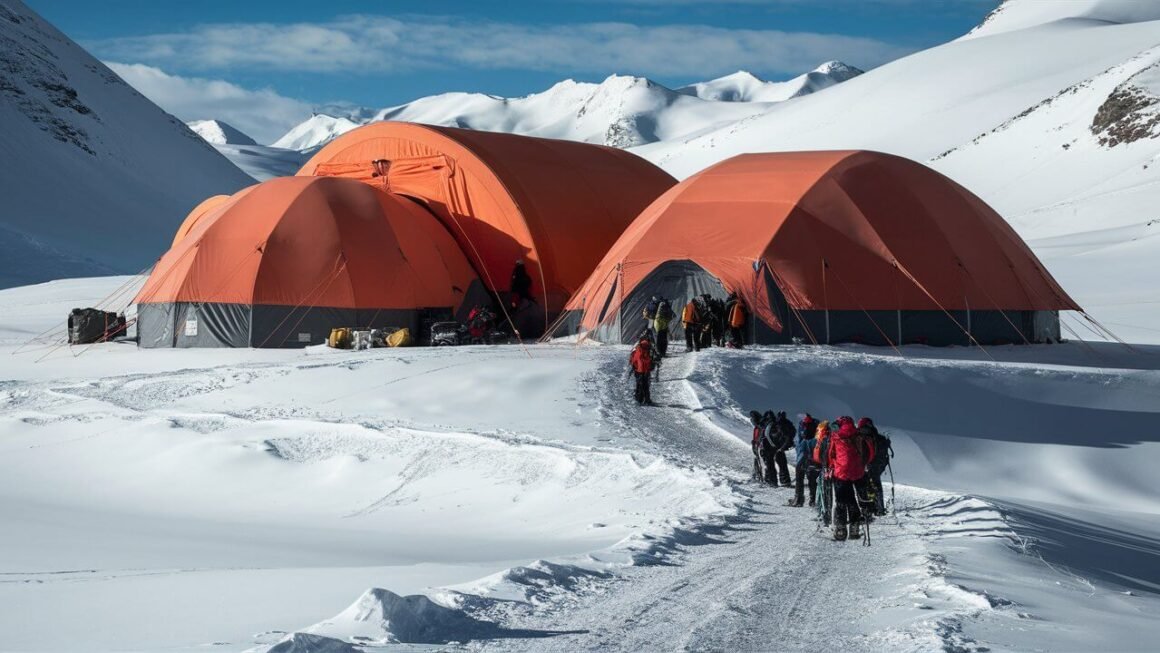Introduction
Just Imagine the tranquility of a starlit sky, cocooned within a spacious 4-person tent after a day of hiking with loved ones. Such moments epitomize the joy of camping, where a well-chosen tent becomes your heaven in the great outdoors.

A 4-person tent is not merely a shelter; it’s a crucial element of your camping experience, offering comfort and protection while fostering shared adventures. In this comprehensive guide, we will explore everything you need to know about buying a 4-person tent in 2024, tailored for families, backpackers, and festival-goers alike.
Essential Considerations Before You Buy
Before diving into specific tent models, several key factors merit consideration. Firstly, assess the number of campers who will be using the tent regularly to determine adequate space for sleeping and gear storage. Whether you’re embarking on a rugged backpacking trip, setting up base camp for mountain adventures, or enjoying the convenience of car camping, the tent’s weight and size are critical.
When choosing a tent, it’s essential to factor in seasonal variations. A 3-season tent suffices for most camping adventures, offering ventilation and protection against moderate weather conditions. In contrast, a 4-season tent is designed for brassy climates, providing insulation and strong construction to withstand snow and strong winds.
Balancing portability and interior space is crucial. Lightweight tents are ideal for backpackers, prioritizing easy transport and quick setup. Conversely, larger tents cater to car campers, offering ample room for families or groups, along with additional features like multiple doors for accessibility and vestibules for gear storage.
Budget considerations play a pivotal role in tent selection, influencing the range of features and quality you can expect. Set realistic expectations based on your camping style and desired comfort level, ensuring your investment meets your long-term camping needs.
Key Features of 4-Person Tent
The structure of a 4-person tent varies across different types, each with its own advantages. Dome tents are popular for their stability and ease of setup, while cabin-style tents provide more vertical space and roominess. Backpacking tents emphasize lightweight materials and compact packing, ideal for trail enthusiasts seeking minimal weight without compromising on weatherproofing.
Livability within a 4-person tent is defined by its floor space and layout. Adequate room for sleeping and gear storage enhances comfort during extended stays, while multiple doors and vestibules offer convenient entry and additional storage options for equipment and muddy boots.
| Features | Description |
| Structure | Various types: dome, cabin, backpacking. Each type offers different pros and cons in terms of stability, space, and ease of setup. |
| Floor Space and Layout | Sufficient room for sleeping and gear storage. Consider additional features like room dividers or storage pockets for organization. |
| Doors and Vestibules | Multiple doors for easy access and ventilation. Vestibules for storing gear and keeping the interior clean and dry. |
| Ventilation | Mesh panels, windows, and adjustable vents to regulate airflow and reduce condensation. |
| Weatherproofing | Quality rainfly with sealed seams and waterproof materials to keep occupants dry in rainy conditions. |
| Setup Ease | Quick and intuitive setup mechanisms, including color-coded poles and freestanding designs. |
| Portability | Lightweight materials suitable for backpacking or compact packing size for easy transport. |
| Durability | Strong, durable fabrics and components designed to withstand wear and tear from outdoor elements. |
| Extras | Additional features such as gear lofts, electrical ports, and reflective guy lines for enhanced functionality and convenience. |
| Seasonality | Suitable for 3-season or 4-season use depending on weather conditions and insulation needs. |
Proper ventilation is essential for maintaining comfort inside the tent, minimizing condensation and ensuring a pleasant sleeping environment. Look for tents with mesh panels and adjustable vents to regulate airflow, especially in humid or warm conditions.
Rainfly coverage and weatherproofing materials are critical for protecting against rain and wind. High-quality tents feature durable fabrics with sealed seams and waterproof coatings, ensuring dry interiors even during unexpected downpours or windy nights.
Top Considerations for Different Camping Styles
- Choosing the right 4-person tent involves tailoring your selection to your specific camping style. Backpackers prioritize lightweight designs that pack down small, yet offer reliable weather protection and durability on the trail. Look for tents with reinforced seams and robust poles to withstand rugged terrain and unpredictable weather conditions.
- Car campers benefit from spacious tents that provide ample room for gear and activities. Consider features like multiple rooms or dividers for privacy, along with enhanced ventilation systems to maintain airflow in larger spaces. Easy setup and teardown are also crucial for quick getaways and minimal hassle when transitioning from site to site.
- For families, a 4-person tent should offer ease of setup and a layout that accommodates both adults and children comfortably. Look for tents with spacious interiors, multiple doors for easy access, and optional features like built-in storage pockets or electrical ports for added convenience during extended stays.
- Festival-goers require tents that are quick to pitch and dismantle, making pop-up or instant tents ideal choices. Weather resistance is paramount, with features like taped seams and integrated rainflys providing protection from sudden rain showers or windy conditions common at outdoor events.
Reviewing Popular 4-Person Tents in 2024

To assist in your decision-making process, we’ve reviewed several leading 4-person tents currently available in 2024. Each review highlights key features, specifications, and suitability for different camping styles, ensuring you find the perfect tent to enhance your outdoor adventures.
Conclusion and Pro Tips
In conclusion, purchasing a 4-person tent involves thoughtful consideration of factors such as size, weight, features, and budget. By aligning these considerations with your specific camping needs, you can ensure a comfortable and enjoyable experience in the outdoors.

Pro Tips
Practice Setup
Familiarize yourself with your tent’s setup procedure well before your camping trip. Set it up at home or in your backyard to become familiar with the steps and ensure all components are present. This practice not only reduces stress but also allows you to troubleshoot any issues and streamline the setup process during your actual trip.
Consider Extras
Invest in accessories like a tent footprint or additional stakes to prolong the lifespan of your tent and enhance weather protection.
- Tent Footprint: A tent footprint serves as a protective layer between the tent floor and the ground. It prevents abrasion, punctures, and moisture from seeping through, thus prolonging the lifespan of your tent. Choose a footprint specifically designed for your tent model or customize one to fit.
- Additional Stakes and Guy Lines: Depending on your camping terrain, consider carrying extra stakes and guy lines. These accessories provide additional stability in windy conditions and allow you to securely anchor your tent, minimizing movement and ensuring it remains firmly in place.
- Gear Loft and Storage Pockets: Many 4-person tents come equipped with built-in gear lofts and storage pockets. These features help organize your belongings inside the tent, keeping essentials like headlamps, smartphones, and maps easily accessible. Utilize these spaces efficiently to maximize interior comfort and organization.
- Repair Kit: Pack a small repair kit containing patches, seam sealant, and spare parts for quick fixes in case of minor damages during your trip. Addressing issues promptly can prevent further damage and extend the lifespan of your tent.
- Tent Lights: Illuminate your tent interior with battery-operated LED lights or lanterns designed for camping. These lights provide ambient lighting during nighttime activities and make it easier to navigate inside the tent without disturbing other campers.
- Groundsheet or Tarp: In addition to a tent footprint, consider carrying a groundsheet or tarp to create a clean and dry area outside your tent. This space can be used for cooking, lounging, or storing gear, enhancing overall campsite comfort and cleanliness.
Maintenance Tips
Proper maintenance is crucial for prolonging the lifespan of your 4-person tent:
- Cleaning: After each camping trip, thoroughly clean your tent to remove dirt, mud, and debris. Use a soft brush or sponge, mild soap, and lukewarm water to clean the fabric, zippers, and poles. Avoid using harsh chemicals or washing machines, as they can damage the waterproof coating.
- Drying: Always ensure your tent is completely dry before storing it. Hang it in a well-ventilated area away from direct sunlight to prevent UV damage to the fabric. Storing a damp tent can lead to mold, mildew, and unpleasant odors.
- Storage: Store your tent loosely packed in a cool, dry place. Avoid compressing it tightly for extended periods, as this can stress the fabric and seams. Use a storage sack or mesh bag to allow air circulation and prevent creasing.
- Inspection: Before each trip, inspect your tent for any signs of wear and tear, including tears, punctures, or degraded waterproofing. Address any issues promptly with repairs or replacements to maintain optimal performance in the field.
Bonus Section: Frequently Asked Questions
What should I consider when choosing a 4-person tent for backpacking?
For backpacking, prioritize lightweight tents with good weatherproofing and compact packing size.
Are 4-person tents suitable for families with small children?
Yes, many 4-person tents offer ample space and features like room dividers and storage pockets, making them ideal for family camping.
How do I maintain a 4-person tent to prolong its lifespan?
Regularly clean your tent after each use, store it dry and ventilated, and avoid prolonged exposure to UV rays to extend its durability.
What are the benefits of choosing a 4-season tent over a 3-season tent?
season tents are designed for use in harsher weather conditions, including snow and strong winds. They typically feature more robust construction, stronger poles, and weatherproof materials to withstand winter camping. However, they may be heavier and less ventilated compared to 3-season tents, which are better suited for moderate weather conditions during spring, summer, and fall.
This comprehensive guide equips you with the knowledge needed to select the best 4-person tent for your adventures in 2024. Whether you’re camping with family, embarking on a solo backpacking journey, or enjoying festivals with friends, choosing the right tent ensures comfort, protection, and memorable outdoor experiences.
Conclusion
Choosing the right 4-person tent involves considering a range of factors, from camping style and weather conditions to budget and desired features. By understanding these considerations and exploring our curated reviews of popular tents for 2024, you’re well-equipped to make an informed decision that enhances your outdoor experiences.
Remember to prioritize comfort, durability, and functionality when selecting your tent, ensuring it meets the needs of your camping adventures for years to come. Whether you’re planning a family camping trip, a solo backpacking expedition, or attending a festival with friends, the right 4-person tent can make all the difference in your enjoyment and comfort in the great outdoors.
For more tips and tricks to enhance your camping experience, don’t miss out on reading https://budgetcampingspot.com/things-to-do-while-camping/



